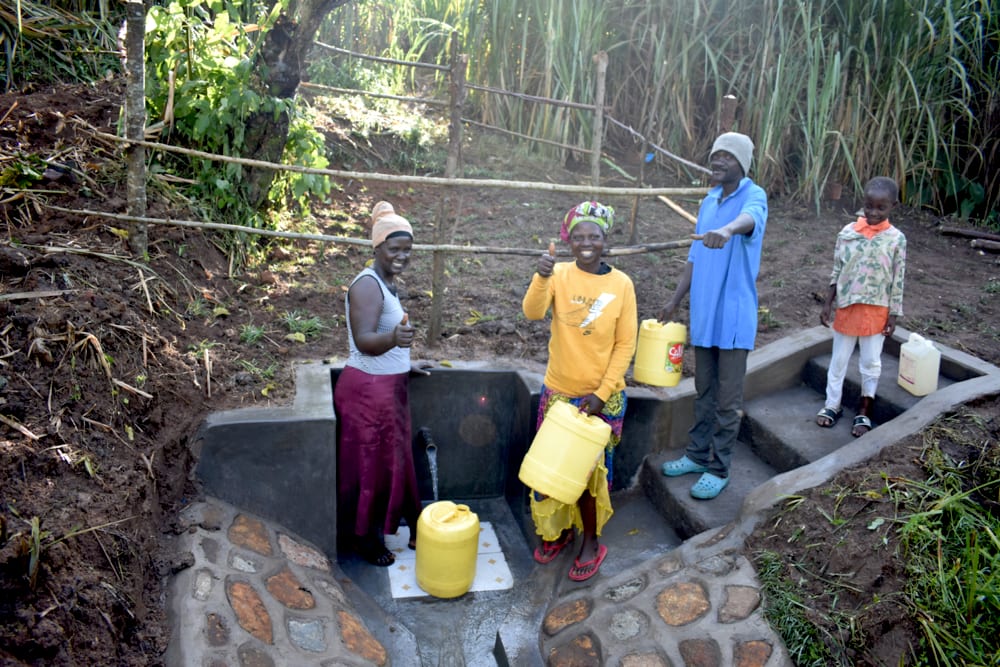"When I was diagnosed with typhoid I got scared of using the water, so whenever I have some money I have to buy drinking water which is very expensive for me, "said expecting mother Jamila Mwibanda.
Jamila is 1 of 140 people in Musango who depend on Wabuti Spring for all of their daily water needs. And yet, the spring does not provide clean or safe water. Because accessing enough water is crucial to daily life for drinking, cooking, cleaning, and handwashing, Wabuti Spring is holding people back from reaching their full potential in sanitation, hygiene, and all aspects of their lives.
Jamila walked us through her daily routine as an example of the spring's impact.
At 7:00 am Jamila wakes up, then goes to fetch her first jerrycan of water for the day. Once she returns home, she uses the water to prepare breakfast and to clean the dirty utensils from last night's dinner and the day's breakfast. Jamila again goes for water, making 2 trips this time to have enough water for washing and bathing. At midday, Jamila fetches water for preparing lunch. Around 2:00 pm, she goes for water for the cows and for cooking dinner. Her day ends at 9:00 pm, and the cycle continues in the morning.
On a normal day, Jamila goes to the spring approximately 7 times, but she can make as many as 10 trips depending on her water needs for the day. Though she tries to buy water when she can, Jamila still has to use the spring water when there is not enough money to do so. Most community members cannot afford to buy water. And while we cannot change the number of times someone must go to the spring for water, we can change how long they spend while they're there and the quality of water they collect.
"The water becomes dirty immediately with 1 scoop, so I have to wait; it's so tiring and I wait and take a lot of time," said teenager Chrisantus.
In its current state, the spring is open to contamination from dirty surface runoff which carries farm chemicals and animal waste, among other contaminants. People frequently catch dogs drinking directly from the spring, and there is a constant layer of algae that people have to clear to fetch water.
The process of fetching is long, tiring, and frustrating. Because the small pool of water that forms from the spring is shallow, community members cannot submerge their containers to fill them. Instead, they must use a small jug or bowl to scoop water first from the pool, then pour it into their larger jerrycans.
There is supposed to be a communal jug that stays at the spring since everyone has to fetch water the same way, but sometimes it gets misplaced. This wastes even more time as people have to return home to find another container to use at the spring. People then start accusing their neighbors of who took the jug, causing discord in the community. There are also conflicts at the spring due to fetching water that got stirred up with mud by others. Because of this, some people do not want to wait and they jump the queue, causing even more tension among all present.
Community members report a myriad of water-related illnesses after consuming water from Wabuti Spring including typhoid, sore throat, and amoeba. These illnesses cause families to spend their resources seeking medical treatment, and they steal time from kids' learning at school and adults' time spent working and earning income.
What We Can Do:
Spring Protection
Protecting the spring will help provide access to cleaner and safer water and reduce the time people have to spend to fetch it. Construction will keep surface runoff and other contaminants out of the water. With the community’s high involvement in the process, there should be a good sense of responsibility and ownership for the new clean water source.
Fetching water is a task predominantly carried out by women and young girls. Protecting the spring and offering training and support will, therefore, help empower the female members of the community by freeing up more of their time and energy to engage and invest in income-generating activities and their education.
Training on Health, Hygiene, COVID-19, and More
To hold trainings during the pandemic, we work closely with both community leaders and the local government to approve small groups to attend training. We ask community leaders to invite a select yet representative group of people to attend training who will then act as ambassadors to the rest of the community to share what they learn. We also communicate our expectations of physical distancing and wearing masks for all who choose to attend.
The training will focus on improved hygiene, health, and sanitation habits in this community. We will also have a dedicated session on COVID-19 symptoms, transmission routes, and prevention best practices.
With the community’s input, we will identify key leverage points where they can alter their practices at the personal, household, and community levels to affect change. This training will help to ensure participants have the knowledge they need about healthy practices and their importance to make the most of their water point as soon as water is flowing.
Our team of facilitators will use a variety of methods to train community members. Some of these methods include participatory hygiene and sanitation transformation, asset-based community development, group discussions, handouts, and demonstrations at the spring.
One of the most important issues we plan to cover is the handling, storage, and treatment of water. Having a clean water source will be extremely helpful, but it is useless if water gets contaminated by the time it is consumed. We and the community strongly believe that all of these components will work together to improve living standards here, which will help to unlock the potential for these community members to live better, healthier lives.
We will then conduct a small series of follow-up trainings before transitioning to our regularly scheduled support visits throughout the year.
Training will result in the formation of a water user committee, elected by their peers, that will oversee the operations and maintenance of the spring. The committee will enforce proper behavior around the spring and delegate tasks that will help preserve the site, such as building a fence and digging proper drainage channels. The fence will keep out destructive animals and unwanted waste, and the drainage will keep the area’s mosquito population at a minimum.
Sanitation Platforms
At the end of the training, participants will select 5 families that should benefit from new concrete latrine floors called sanitation platforms. Training will inform the community and selected families on what they need to contribute to make this project a success. They must mobilize locally available materials, including bricks, clean sand, and gravel.
The 5 families chosen for sanitation platforms must prepare by sinking a pit for the sanitation platforms to be placed over. Our trainers then instruct them on how to build superstructures over their new platforms. These 5 sanitation platforms will serve as examples for the rest of the community to replicate.
All community members must work together to make sure that they continuously provide accommodations and food for the work teams throughout all stages of spring and sanitation platform construction.

 Protected Spring
Protected Spring
 Rehabilitation Project
Rehabilitation Project














































